“A Covenant Restored,” Ensign, July 1990, 32
A Covenant Restored
The new permanent exhibit at the Museum of Church History and Art tells the story of conversion and commitment among Latter-day Saints.
Have you ever wondered what it would feel like to sit in a covered wagon as it rumbled across the plains in 1847 headed for the Salt Lake Valley, or to sleep in a small bunk between decks on board ship in 1856 as it struggled across the Atlantic Ocean on its way to America? Well, now you can do both—and more—at the new permanent exhibit at the Museum of Church History and Art.
The new 8,000-square-foot exhibit is no ordinary display. From the shimmering silence of the alcove near the entrance, with its stained-glass window containing the story of the First Vision, to the gazebo near the exit with its diorama of a turn-of-the-century Pioneer Day celebration, this exhibit captures the imagination. It invites visitors to participate in the early Mormon experience, including the restoration of the gospel in New York; the gathering of the Saints in Ohio and Missouri and later in Illinois; the migration of the Saints to the Salt Lake Valley by ship, covered wagon, and handcart; the building up of Zion in the American West; and the proclamation of the gospel to the world.
The exhibit features rarely seen artifacts, such as the original manuscript of the Book of Mormon translation in Oliver Cowdery’s own handwriting, as well as old favorites, such as the pocket watch that stopped a bullet and saved John Taylor’s life at Carthage Jail. The exhibit also highlights impressive reconstruction of buildings created especially for the museum—such as a section of the wall of the Nauvoo Temple built from original temple stones.
Large topographically accurate maps provide an overview of the 1846–1847 trek from Nauvoo to Salt Lake City, the sea routes of the Saints from around the world to America, and the settlement of the West by Latter-day Saint pioneers. Exquisitely detailed models provide a look into the past at such places as the Joseph Smith farm in Palmyra, New York, during the fall of 1827, the nineteenth-century ship Enoch Train in 1856, and Salt Lake City in the spring of 1870.
But however imaginative the displays, the exhibit isn’t a travelogue. Don L. Enders, senior curator at the museum, says that “a significant message flows through this entire exhibit, and we hope it will change the lives of the people who visit it.” That message centers around the theme—“A Covenant Restored.”
“A Covenant Restored”
“This exhibit and its message are the principal reasons the museum was built,” says Steven L. Olsen, project manager. “Our goal has been to interpret the religious foundations of the Church in terms of the covenants Latter-day Saints make, not just to tell stories in chronological order. Covenants, both individual and group, define what it means to be a Latter-day Saint. Only events that interpret Church history in terms of Latter-day Saints as a covenant people were selected for display,” he says.
“By the time visitors leave,” says Brother Enders, “they should know the answer to these questions: ‘How was the gospel restored?’ ‘Why do people become Latter-day Saints?’ and ‘How do Latter-day Saints work together to build the kingdom of Zion—both past and present?’ We hope visitors discover that a combination of conversion, covenants, and community is the answer.”
Innovation and Interaction
“The idea for an exhibit such as this was conceived even before this museum was built,” says Glen M. Leonard, museum director. “The actual construction and fabrication of the exhibit have been going on for about three years, but the research, planning, and designing have been going on for more than a decade.”
Hundreds of people have been involved in the development of “A Covenant Restored”: administrators, curators, designers, conservators, educators, catalogers, photographers, and builders. Steve Olsen has coordinated these groups as they have met together to develop everything from the broad scope of the message to the most minute detail of display and fabrication.
The experience of these teams is not unlike the experience of the early Saints, who are the heart of this exhibit; they, too, were gathered together from a wide variety of backgrounds and learned to work together to build the Church.
This team effort has produced a more accurate and exciting exhibit than those produced by the traditional approach of merely displaying artifacts; it has resulted in some of the most innovative ideas for using artifacts in museums today. One of these innovations is to put artifacts in an environmental setting. Whenever possible, the museum teams chose a specific time and place that was representative of a larger time and place and then recreated that setting as accurately as possible to help visitors imagine the event.
For example, a little piece of time has been “frozen” at the display of the construction of the Nauvoo Temple. An unfinished sunstone rests in front of the Nauvoo Temple wall, along with actual tools used in the building of the temple, with chips from the sunstone scattered nearby on the ground. It is as if the stonemason has left his work temporarily and you have simply wandered over to the temple site to see his work.
Also among the innovations are interactive displays that encourage visitors to push buttons, to view videos, even to climb into a covered wagon and a ship’s bunk. By pressing a button, a visitor can illuminate tiny red lights on a twelve-foot-high computer-driven map of the Mountain West and identify the 725 Mormon settlements by groups as they were established between 1847 and 1930. Videotaped messages accompany the display. Models of the Joseph Smith farm in 1827 and of Salt Lake City in 1870 are also equipped with buttons that, when pressed, highlight specific parts of the model and give recorded explanations of the events that took place there.
Challenges and Solutions
The creative ideas found throughout the exhibit did not come without effort and inspiration. Members of the museum staff say that on many occasions, solutions to challenges came about surprisingly. For example, they wanted to use original paving-stone on the floor of the area representing Salt Lake City. Knowing that original paving-stone still exists under a few of Salt Lake City’s streets, they had tried for two years without success to obtain stone from street repair sites. The day after the staff decided to abandon the idea and to use simulated stone instead, Kirk Henrichsen, exhibit designer, noticed construction on South Temple Street near the south gate of Temple Square. He immediately took a closer look at the excavation and saw original paving-stone under the recently removed asphalt. Arrangements were made, and soon the salvage company that had purchased the paving-stones donated six dump-truck loads to the museum.
According to Brother Olsen, one of the most difficult challenges was “communicating something spiritual through temporal means.” The museum teams faced that challenge as they had others: “We have been prayerful as well as professional in our decisions about the selection of art work, documents, and artifacts,” he says.
For example, a baby’s blessing gown is displayed in a quiet area of the exhibit. Although this exquisite white gown doesn’t draw immediate attention like the brilliance of the stained-glass window does, it has a subtle power all its own that symbolizes the spirit of the entire museum. While traveling by ship and wagon westward to be with her fiancé, a young Englishwoman, Hannah Smith, hand-worked a single piece of fabric into delicate eyelet that became the gown’s long skirt. She labored over its stitches not only in anticipation of the birth of her own children, but also as part of her desire to leave a legacy for her posterity. Eventually eighty-six descendants of Hannah Smith London were blessed in this gown, benefiting from her sacrifice and faith in the restored gospel.
Hannah Smith London’s efforts mirror the actions of thousands of other Saints who have labored not only for themselves and their immediate families, but also in anticipation of the legacies they could leave for others. These thousands of acts of faith by early and modern-day members are the heart and spirit of “A Covenant Restored.”
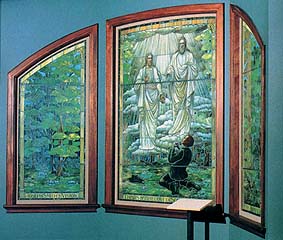
2. The Prophet Joseph Smith’s First Vision is portrayed in this 1913 stained-glass window originally located in the Adams Ward chapel in Los Angeles, California. This quiet alcove provides a place of peaceful transition and sets the theme of the exhibit as a religious history.

9. Joseph Smith directed the affairs of the Church in Nauvoo from an office in his red-brick store. Its handpainted tin sign is the earliest known sign identifying the office of a President of the Church.
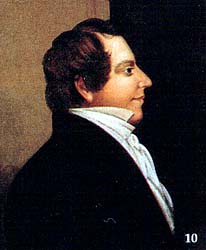
10. Profile of the Prophet Joseph Smith, painted in Nauvoo in 1842.
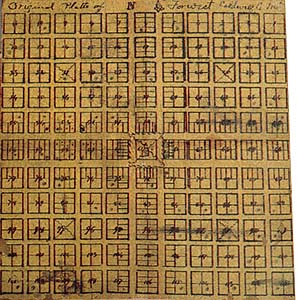
11. This newly discovered original plat of Far West, Missouri, drawn on sheepskin, served as a model for all the stakes of Zion and is a significant find for the museum. The ideals of Zion—worship, order, and peace—are reflected in the plat, which places the temple in the center of the city, with the four streets adjacent to the temple block wider than the other streets. The remaining 640 acres are divided into lots for homes.

13. An ink-and-graphite rendering of the west elevation of the temple was drawn by the temple’s architect, William Weeks, in 1844.
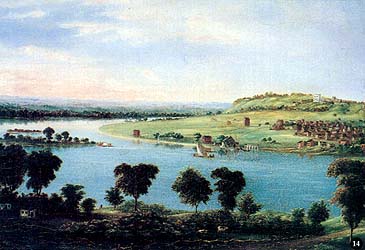
14. An oil painting of Nauvoo in 1860, fifteen years after the Saints left, gives us a clear view of the city and the lay of the land surrounding it.

18. This covered wagon is partially stocked as it would have been for the trek west.

20. A bronze statue by Avard Fairbanks, titled Tragedy at Winter Quarters, commemorates the deaths of hundreds of Saints during the first two years at Winter Quarters.

23. Museum visitors can climb into one of the three-foot bunks designed for a pioneer family.
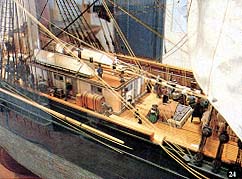
24. Scenes on deck are patterned after actual events recorded in pioneer journals for 6 April 1856. Miniatures of the 534 people on board are handmade; accuracy has been maintained in such details as clothing. The passengers on this voyage were mostly from England; the rest came from Scotland, Wales, Ireland, Denmark, and Switzerland.

26. Part of the interior of the Salt Lake City Fourth Ward chapel, erected in 1886, has been reconstructed to show how the Saints worshiped. The pulpit, railing, and sacrament table are from the Glenwood meetinghouse in central Utah. The stained-glass window, made about 1910, is from the Salt Lake Fourteenth Ward meetinghouse.
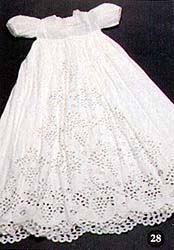
28. This blessing gown, including the eyelet skirt, was handsewn.
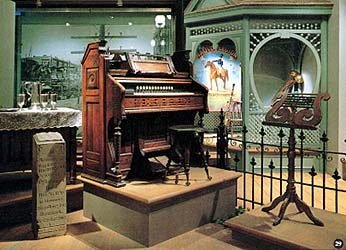
29. An organ from the Manti Temple is a reminder of the importance of music to Latter-day Saints.
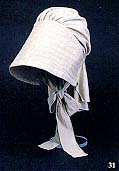
31. A cotton sunbonnet made after 1879 in Orderville, Utah, the most successful of Utah’s united-order communities.
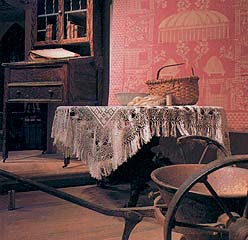
32. Samples of work from the Church’s economic missions include this secretary from the Paris, Idaho, united order and this wool blanket woven at the Knight Woolen Mills. This ore cart was used inside the foundry at the Minersville lead mission in 1859.
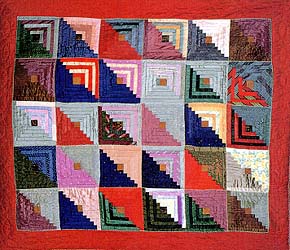
34. This hand-stitched quilt displaying the log-cabin pattern was made from Utah silk.
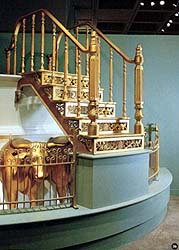
36. A section of the Logan Temple baptismal font (removed from the temple during remodeling in 1976) rests upon the backs of twelve oxen and represents another element of temple worship—baptism for the dead.

38. This oil sketch, attributed to Edwin Evans, was made about 1892. In the early 1890s, the Church sent several “art missionaries” to study in Paris, France, in preparation for the task of painting the Salt Lake Temple murals depicting the creation of the earth, the Garden of Eden, and the world in which we live.
1. The Museum of Church History and Art lies west of Temple Square, across the street.
3. Early converts to the Church came from many different backgrounds. Eight are represented here with some of their belongings (from left): Emer Harris, a carpenter who left his home in New York state and helped build the Kirtland Temple; Oliver Cowdery, a schoolteacher who transcribed much of the Book of Mormon translation; Elizabeth Ann Whitmer Cowdery (sitting), wife of Oliver Cowdery and daughter of David Whitmer; David Whitmer, a farmer’s son converted through his friend Oliver Cowdery and who was one of the Three Witnesses to the Book of Mormon; Hiram Page, a physician from Vermont who was one of the Eight Witnesses to the Book of Mormon; Eliza R. Snow, a writer and a poet who later served as second general president of the Relief Society; Brigham Young, a carpenter who joined the Church after reading the Book of Mormon, and who later served for thirty years as President of the Church; and Heber C. Kimball, a potter who served as an Apostle, a missionary to England, and a counselor to Brigham Young. 4. This 1830 edition of the Book of Mormon belonged to Martin Harris, who mortgaged his farm to pay for the first printing of the Book of Mormon. 5. A meticulously built model of the Joseph Smith, Sr., 100-acre farm as it appeared in September 1827 in Palmyra, New York. The Sacred Grove is located in the woods across the field from the Smiths’ log home and their newly completed frame house. 6. E. B. Grandin used this press to print five thousand copies of the Book of Mormon in Palmyra, New York, between 1829 and 1831.
Here we can see the contrast between the rugged frontier life of the Saints, represented by (7) a facade of an 1839 log home from a Latter-day Saint settlement in northwest Missouri, and their gospel ideals, represented by (8) an original window from the Kirtland Temple. Early converts sacrificed time, skills, money, and even their fine china to build the Kirtland Temple, which was completed in March 1836. To the right of the window is an oil painting of Joseph Smith and the Church leaders in Nauvoo, W. W. Phelps’s lap desk and journal, and Hyrum Smith’s vest and pants.
The Nauvoo Temple, built on the highest point of the city, was a symbol of hope for early converts. For more than five years, the construction of this temple was the central focus of Nauvoo’s economic, civic, and religious life. As the first rooms were finished in the basement, they were dedicated and priesthood ordinances were begun. The Saints received their endowments as the upper section of the temple was completed and dedicated. The finished temple was 128 feet high, 88 feet wide, and 165 feet from the ground to the top of the tower. This fifteen-foot-high by twenty-foot-wide section of the temple facade (12) was reconstructed from original temple stones salvaged after the temple was destroyed by fire and a tornado more than a century ago. 15. Actual tools used in the construction of the Nauvoo Temple.
16. A replica of a typical covered wagon used by the Saints. 17. C. C. A. Christensen’s painting of Winter Quarters, 1846–47; 3,500 Latter-day Saints built seven hundred log homes that provided shelter for thousands of pioneers traveling west between 1846 and 1862. 19. Brigham Young’s compass, originally inscribed with “PBY” for “President Brigham Young,” is only as large as a nickel.
Church leaders established the Perpetual Emigrating Fund (PEF) to help needy members of the Church emigrate to Utah. Latter-day Saints in Utah and elsewhere donated money, food, clothing, livestock, and wagons to the PEF, and the emigrating Saints agreed to replenish the fund after their arrival in Zion. More than one hundred thousand Latter-day Saints were helped during the PEF’s 38-year existence. Thousands of Latter-day Saint converts sailed safely from Europe to America on passenger ships like the Enoch Train (21), replicated here as a 1:32 scale model. Four years in the building, this model is accurate in details as minute as the sailor’s knots tied in the lines to the sails. It required seven months to cover the model ship’s hull with more than two thousand small copper plates, each requiring thirty copper nails. A side panel has been removed from the hull of the model to reveal the area of the ship known as “‘tween decks,” where the pioneer emigrants slept. The model has been wired with tiny lights so that the ship’s interior can be seen clearly. 22. A life-size replica of “‘tween decks” has been built here from the same types of wood used originally: yellow pine for the lower deck, eastern white pine for the upper deck, and white oak for the round supports under the deck.
25. Salt Lake City, as it appeared in spring 1870, is accurately reproduced in miniature on this eleven-foot-square model of sixty-four blocks of the city. On the model are 5,000 trees, 700 homes, and more than 1,500 other structures. 27. This hand-carved wooden sunburst, once painted brilliant colors, was part of the south gable of the Old Tabernacle that stood on Temple Square where the Assembly Hall is now located.
30. Visitors step through the original pressed-tin store front of America’s first department store, Zion’s Cooperative Mercantile Institution (ZCMI), for a look at Utah’s pioneer economy. 33. The $5.00 scrip note was issued by ZCMI for use in its retail stores. The $2.50 gold piece was minted in 1849 from gold dust brought to Utah by members of the Mormon Battalion. The $5.00 gold piece was minted in 1860 by the Deseret Mint.
35. Sacred temple worship is represented by these handcrafted doors and an altar from the Manti Temple. Made by skilled craftsmen in the mid-1880s, they are reminders of one element of temple worship—the sealing of families for eternity. The fine construction detail, furnishings, and art combine to express the Saints’ reverence for their temples. 37. An iron gate from Temple Square.
39. A colorful montage of international art represents the growth of the restored gospel into a worldwide church. Shown here are a hand-loomed wool blanket made in Guatemala featuring the Book of Mormon, a circular wood-carving of Lehi’s dream of the tree of life from Venezuela, and other works of inlaid wood or multilayered fabric-applique (molas.) 40. This wool rug depicts two LDS missionaries approaching a Navaho hogan in Monument Valley, Arizona. It was sheared, carded, spun, dyed, and woven by hand by a sister who was converted to the gospel by two such missionaries.
This exhibit includes objects as diverse as an armoire, handpainted in 1986 in the rococo painting style common in Austria in the 1830s, showing scenes from Church history; a fired-clay nativity scene with the polished black surface distinctive of Santa Clara Pueblo pottery; and a pair of black-python-and-buffalo-calfskin boots with sea gulls memorialized in their design. Also in this exhibit are a sculpted wood bas-relief depicting the five wise virgins from the parable of the ten virgins; scenes and landscapes of pioneer settlements depicted in cut paper after the manner of Scandinavian folk art; and three batiks from Indonesia showing the Salt Lake Temple, Joseph Smith receiving the golden plates, and an Indonesian LDS meetinghouse.
Photography by Craig Dimond and Ron Read